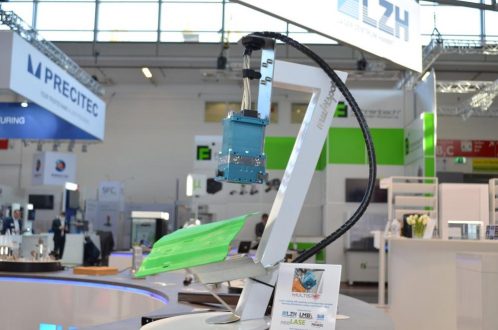
Insights from the Field: Ensuring Workplace Safety Using Thermal Camera Screening for Entry Control
Epidemics and pandemics can leave large enterprises that employ and receive thousands of people vulnerable to widespread infection and business interruptions. Without the right entry protocols in place, an employee who has symptoms of an infectious disease, such as a fever, could enter a facility and put the entire workforce at risk of exposure.
Elevated Skin Temprature Screening
Major businesses are ramping up their workforce safety best practices by deploying FLIR thermal cameras for elevated skin temperature measurement. Registered with the U.S. Food and Drug Administration (FDA), these non-contact thermal cameras measure skin surface temperature at the inner canthus (or corner of a person’s eye). FLIR thermal cameras that are engineered for elevated skin temperature screening can achieve accuracies of ±0.3°C (0.5°F) over a temperature measurement range of 15°C to 45°C (59°F to 113°F). This aligns with the U.S. FDA Guidance for Industry and Food and Drug Administration Staff as well as with ISO/TR 13154 specification. FLIR provides an array of cameras for elevated skin temperature screening in multiple form factors—including handheld, tripod mounted, or fixed-mounted—optimized for a variety of application needs.
Infrared thermography can detect elevated skin temperatures, which may indicate the presence of a fever. When followed by a screening with a medical device designed specifically for measuring body temperature, such as a thermometer, the use of an infrared camera as an adjunctive diagnostic tool may help contain or limit the spread of viral diseases such as bird flu, swine flu, or COVID-19.
Case In Point
In the wake of COVID-19, businesses across the critical infrastructure market rapidly adopted thermal cameras for elevated skin temperature screening. In the utilities sector, the Office of Cybersecurity, Energy Security and Emergency Response notes how energy utilities are updating their entry protocols in response to COVID-19. Practices now include wellness questionnaires to check for symptoms as well as temperature checks conducted through tools such as thermal cameras.
General Motors (GM) is one of the world’s largest manufacturers of motor vehicles, has over 85,000 employees in the United States, and has some plants that employ 1,000 people in a given shift. In May 2020, GM deployed 377 FLIR thermal cameras across 72 sites to help limit the spread of COVID-19. Healthcare facilities are also installing FLIR solutions; for example, the VA Medical Center in Manchester, New Hampshire deployed FLIR thermal cameras to screen all patients and staff for elevated skin temperature prior to them entering the building.
In the transportation sector, Emirates airlines deployed FLIR thermal cameras at departure gates for all U.S. gateways beginning in March 2020. Guests travelling on U.S. bound flights out of the Dubai International Airport are screened for elevated skin temperature.
Greater Adoption Into Security Solutions
As more critical infrastructure organizations deploy thermal cameras for elevated skin temperature screening, they will likely prompt greater long-term adoption and integration of radiometric thermal cameras into the overall security and safety solution. Here’s why.
While temperature screening of employees and guests often falls under the purview of Environmental Health and Safety or Occupational Health and Safety teams, not every business has a dedicated EHS or OHS staff. As a result, many organizations are tasking their security teams to vet and implement screening solutions. Security officers as well as security equipment, such as surveillance cameras and metal detectors, are already in place at key entry points in a facility. As a result, many security officers must play a dual role as the frontline personnel required to use handheld or tripod mounted thermal cameras to conduct elevated skin temperature screening. Adding a thermal camera for elevated skin temperature screening is a logical addition to existing video surveillance solutions.
Implementation Recommendations
As critical infrastructure businesses shift their attention toward the long-term implementation of thermal cameras for elevated skin temperature screening, there are multiple deployment practices to consider. Here are the a few recommendations from our team of experts.
Choose a Certified Camera – To ensure optimal reliability and deployment success, choose a thermal camera specifically designed for elevated skin temperature screening with a 510(k) filing (K033967) with the U.S. Food and Drug Administration. When looking to integrate this thermal camera into an existing video management system, make sure the camera is ONVIF-compliant. Other screening standards should be considered including ISO/TR 13154:2017 and IEC 80601-2-59:2017.
Select a Camera with High Resolution – It’s important to use a high-resolution thermal camera for elevated skin temperature screening so you can capture the right pixels to yield accurate readings.
Ensure Proper Distance for Screening – Distance matters. Make sure the camera is placed at the manufacturer’s recommended distance away from the individual so the camera can focus. Ensure the camera is stabilized so that the camera will deliver consistent measurements. Place a neutral backdrop a few feet behind the location where the person will be screened, and only screen one person at a time to identify temperature anomalies.
Measure the Right Spot – While the forehead is easier to quickly screen, it is more susceptible to environmental interferences and more likely to generate measurement errors. Research has shown that the corner of the eye—the region medially adjacent to the inner canthus—provides a more accurate estimate of core body temperature than other areas of skin. This is because skin at the canthi is thin (decreasing insulating effects), is less exposed to environmental factors, and is directly over major arteries which increase blood flow and heat transfer.
Set an Alarm Threshold – For FLIR cameras with a Screen-EST™ mode, set an alarm upon detection of a specific skin temperature compared against a sample average of temperature value. Because skin temperature can vary multiple degrees throughout the day based on the environment and other factors, FLIR Screen-EST mode gathers temperatures from several individuals to determine an average that can be updated throughout the screening operation. This is a defining feature and capability for the FLIR cameras for elevated skin temperature screening.
For more installation and operation tips, visit Frequently Asked Questions: Thermal Imaging for Elevated Skin Temperature Screening.
Founded in 1978, FLIR Systems is a world-leading industrial technology company focused on intelligent sensing solutions for defense, industrial, and commercial applications. FLIR Systems‘ vision is to be "The World’s Sixth Sense, creating technologies to help professionals make more informed decisions that save lives and livelihoods. For more information, please visit www.flir.com and follow @flir.
Teledyne FLIR
Schwieberdinger Straße 60
71636 Ludwigsburg
Telefon: +49 (7141) 488817-0
Telefax: +49 (7141) 488817-99
http://www.flir.de/MV
Press
Telefon: +34 (602) 102-965
E-Mail: n.bazerbachi@mepax.com
![]()



